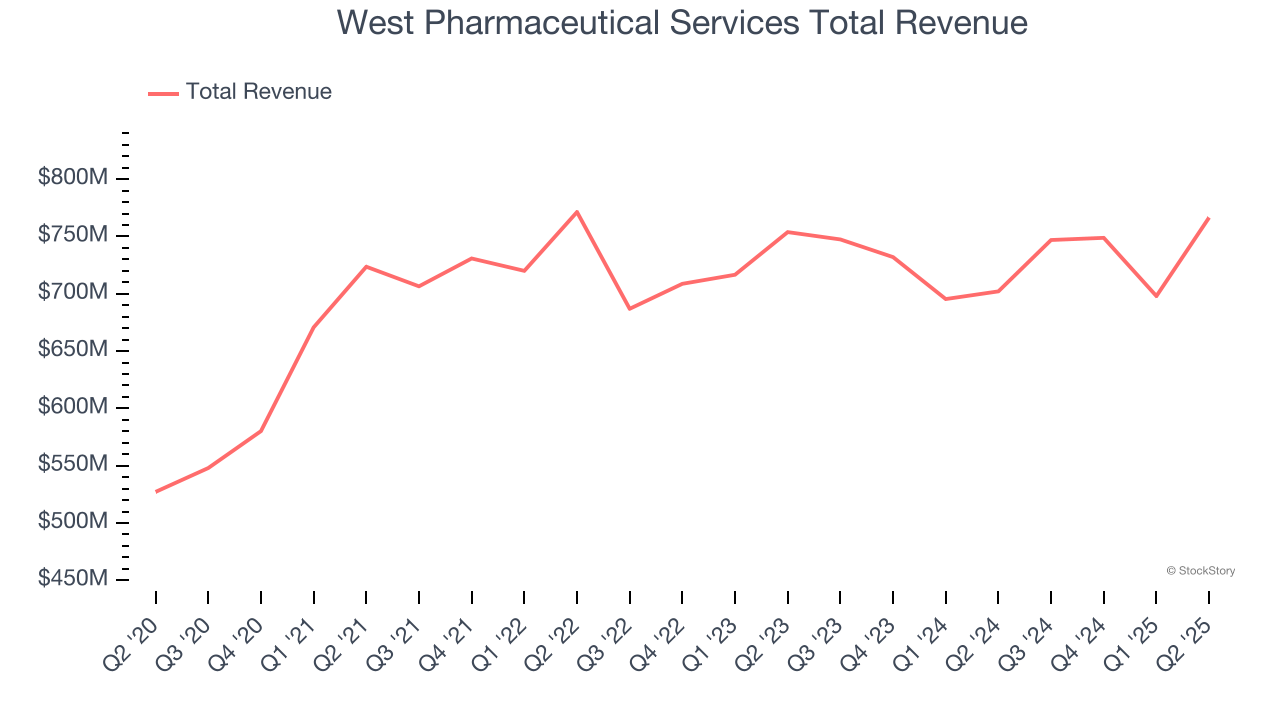
Wrapping up Q2 earnings, we look at the numbers and key takeaways for the drug development inputs & services stocks, including Repligen (NASDAQ: RGEN) and its peers.
Companies specializing in drug development inputs and services play a crucial role in the pharmaceutical and biotechnology value chain. Essential support for drug discovery, preclinical testing, and manufacturing means stable demand, as pharmaceutical companies often outsource non-core functions with medium to long-term contracts. However, the business model faces high capital requirements, customer concentration, and vulnerability to shifts in biopharma R&D budgets or regulatory frameworks. Looking ahead, the industry will likely enjoy tailwinds such as increasing investment in biologics, cell and gene therapies, and advancements in precision medicine, which drive demand for sophisticated tools and services. There is a growing trend of outsourcing in drug development for nimbleness and cost efficiency, which benefits the industry. On the flip side, potential headwinds include pricing pressures as efforts to contain healthcare costs are always top of mind. An evolving regulatory backdrop could also slow innovation or client activity.
The 8 drug development inputs & services stocks we track reported a very strong Q2. As a group, revenues beat analysts’ consensus estimates by 4.4%.
Luckily, drug development inputs & services stocks have performed well with share prices up 14.5% on average since the latest earnings results.
Repligen (NASDAQ: RGEN)
With over 13 strategic acquisitions since 2012 to build its comprehensive bioprocessing portfolio, Repligen (NASDAQ: RGEN) develops and manufactures specialized technologies that improve the efficiency and flexibility of biological drug manufacturing processes.
Repligen reported revenues of $182.4 million, up 14.8% year on year. This print exceeded analysts’ expectations by 4.1%. Overall, it was a strong quarter for the company with full-year revenue guidance beating analysts’ expectations and an impressive beat of analysts’ organic revenue estimates.
Olivier Loeillot, President and Chief Executive Officer of Repligen said, “We had another outstanding quarter in Q2 with 17% organic non-COVID growth. We are very pleased with the momentum we see across the portfolio. This included strength in both consumables and capital equipment, while biopharma demand continues to perform very well. Orders grew over 20%, which represented the eighth quarter in a row of orders exceeding non-COVID revenue and the fifth quarter of sequential order growth. We believe this is a testament to our differentiated strategy, which resulted in 15% organic non-COVID growth in the first half of 2025.

Interestingly, the stock is up 5.3% since reporting and currently trades at $126.
Is now the time to buy Repligen? Access our full analysis of the earnings results here, it’s free.
Best Q2: West Pharmaceutical Services (NYSE: WST)
Founded in 1923 and serving as a critical link in the pharmaceutical supply chain, West Pharmaceutical Services (NYSE: WST) manufactures specialized packaging, containment systems, and delivery devices for injectable drugs and healthcare products.
West Pharmaceutical Services reported revenues of $766.5 million, up 9.2% year on year, outperforming analysts’ expectations by 5.6%. The business had a stunning quarter with a solid beat of analysts’ full-year EPS and revenue guidance expectations.

The market seems happy with the results as the stock is up 10.9% since reporting. It currently trades at $252.22.
Is now the time to buy West Pharmaceutical Services? Access our full analysis of the earnings results here, it’s free.
Weakest Q2: Azenta (NASDAQ: AZTA)
Serving as the guardian of some of medicine's most valuable materials, Azenta (NASDAQ: AZTA) provides biological sample management, storage, and genomic services that help pharmaceutical and biotechnology companies preserve and analyze critical research materials.
Azenta reported revenues of $143.9 million, flat year on year, falling short of analysts’ expectations by 3.8%. It was a softer quarter, leaving some shareholders looking for more.
Azenta delivered the weakest performance against analyst estimates and slowest revenue growth in the group. As expected, the stock is down 3.2% since the results and currently trades at $31.38.
Read our full analysis of Azenta’s results here.
IQVIA (NYSE: IQV)
Created from the 2016 merger of Quintiles (a clinical research organization) and IMS Health (a healthcare data specialist), IQVIA (NYSE: IQV) provides clinical research services, data analytics, and technology solutions to help pharmaceutical companies develop and market medications more effectively.
IQVIA reported revenues of $4.02 billion, up 5.3% year on year. This result surpassed analysts’ expectations by 1.2%. More broadly, it was a satisfactory quarter as it also recorded full-year revenue guidance slightly topping analysts’ expectations.
IQVIA had the weakest full-year guidance update among its peers. The stock is up 20.2% since reporting and currently trades at $190.96.
Read our full, actionable report on IQVIA here, it’s free.
Fortrea (NASDAQ: FTRE)
Spun off from Labcorp in 2023 to focus exclusively on clinical research services, Fortrea (NASDAQ: FTRE) is a contract research organization that helps pharmaceutical, biotech, and medical device companies develop and bring their products to market through clinical trials and support services.
Fortrea reported revenues of $710.3 million, up 7.2% year on year. This number beat analysts’ expectations by 12%. It was a stunning quarter as it also produced a beat of analysts’ EPS estimates and full-year revenue guidance exceeding analysts’ expectations.
Fortrea delivered the biggest analyst estimates beat among its peers. The stock is up 46.5% since reporting and currently trades at $9.63.
Read our full, actionable report on Fortrea here, it’s free.
Market Update
Thanks to the Fed’s series of rate hikes in 2022 and 2023, inflation has cooled significantly from its post-pandemic highs, drawing closer to the 2% goal. This disinflation has occurred without severely impacting economic growth, suggesting the success of a soft landing. The stock market thrived in 2024, spurred by recent rate cuts (0.5% in September and 0.25% in November), and a notable surge followed Donald Trump’s presidential election win in November, propelling indices to historic highs. Nonetheless, the outlook for 2025 remains clouded by potential trade policy changes and corporate tax discussions, which could impact business confidence and growth. The path forward holds both optimism and caution as new policies take shape.
Want to invest in winners with rock-solid fundamentals? Check out our Hidden Gem Stocks and add them to your watchlist. These companies are poised for growth regardless of the political or macroeconomic climate.
StockStory is growing and hiring equity analyst and marketing roles. Are you a 0 to 1 builder passionate about the markets and AI? See the open roles here.





